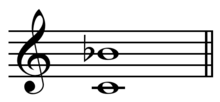Minor seventh
| Inverse | major second |
|---|---|
| Name | |
| Other names | flat seventh |
| Abbreviation | m7, ♭7 |
| Size | |
| Semitones | 10 |
| Interval class | 2 |
| Just interval | 16:9[1] or 9:5[2] |
| Cents | |
| 12-Tone equal temperament | 1000 |
| Just intonation | 996 or 1018 |

In music theory, a minor seventh is one of two musical intervals that span seven staff positions. It is minor because it is the smaller of the two sevenths, spanning ten semitones. The major seventh spans eleven. For example, the interval from A3 to G4 is a minor seventh, as the note G4 lies ten semitones above A3, and there are seven staff positions from A3 to G4. Diminished and augmented sevenths span the same number of staff positions, but consist of a different number of semitones (nine and twelve, respectively).
Use
[edit]Minor seventh intervals rarely feature in melodies (and especially in their openings) but occur more often than major sevenths[according to whom?]. A well-known example, in part due to its frequent use in theory classes, is found between the first two words of the phrase "There's a place for us" in the song "Somewhere" in West Side Story.[3] Another well-known example occurs between the first two notes of the introduction to the main theme music from Star Trek: The Original Series theme.[4]
The most common occurrence of the minor seventh is built on the root of the prevailing key's dominant triad, producing the all-important dominant seventh chord.
During the common practice period the minor seventh was prescribed as a dissonance, requiring resolution to a consonance.[5]
In other temperaments
[edit]In just intonation there is both a 16:9 "lesser just minor seventh", also called the "Pythagorean small minor seventh",[6](ⓘ) equivalent to two perfect fourths stacked on top of each other, and 9:5, called the "greater just minor seventh" (ⓘ)[7][8] equivalent to a perfect fifth and a minor third on top of each other. An interval close in frequency is the harmonic seventh. (ⓘ) [9]
See also
[edit]References
[edit]- ^ Haluska (2003), p. xxiv Pythagorean minor seventh.
- ^ Haluska, Jan (2003). "Just minor seventh". The Mathematical Theory of Tone Systems. p. xxiii. ISBN 0-8247-4714-3.
- ^ Neely, Blake (2009). Piano for Dummies. p. 201. ISBN 0-470-49644-4.
- ^ Wyatt, Keith; Schroeder, Carl; Elliott, Joe (2005). Ear Training for the Contemporary Musician. p. 69. ISBN 0-7935-8193-1.
- ^ Benward; Saker (2003). Music: In theory and practice. Vol. I (7th ed.). p. 53. ISBN 978-0-07-294262-0.
- ^ Breakspeare, Eustace J. (1886–1887). "On certain novel aspects of harmony". Proceedings of the Musical Association. 13th Session: 113–131, esp. 119.
- ^ Perrett, Wilfrid (1931–1932). "The heritage of Greece in music". Proceedings of the Musical Association. 58th Session: 85–103, esp. 89.
- ^ Partch, H. (1979). Genesis of a Music. p. 68. ISBN 0-306-80106-X.
- ^ Dunn, David (2000). Harry Partch: An anthology of critical perspectives. p. 34 – via Google.
